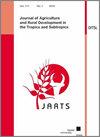盐胁迫对甜瓜种子的影响
Q3 Social Sciences
Journal of Agriculture and Rural Development in the Tropics and Subtropics
Pub Date : 2019-12-16
DOI:10.17170/KOBRA-20191212865
引用次数: 3
摘要
甜瓜是世界上最受欢迎和消费的蔬菜之一,然而,甜瓜产区的灌溉用水含盐量一直在增加。为此,从联邦农村半干旱大学(UFERSA)种质资源库中提取甜瓜,进行了盐度测试,并对幼苗的生理反应进行了评价。对甜瓜24个通道施用0.06和3.45 dS m -1的盐度。为此,使用了4个亚样本,每次使用25个种子,将种子播种在聚苯乙烯托盘中,托盘中有洗涤和灭菌的沙子作为基质,最初以50%的田间容量湿润。设计采用全随机因子方案(2个盐度水平和24个通道)。盐度影响了甜瓜种子的生理品质(萌发和平均萌发时间),平均发芽率为62%,平均萌发时间为4 d,平均高10.5 cm,干物质积累减少。盐水处理增加了土壤饱和提取物的EC,表明存在应力。耐盐通道依次为A35、A24、A41、A31、A09、A28和A43。中等耐受性通道为:A16、A19、A15、A17、A34、A25、A27、A18、A42。耐盐通道为:A45、A08、A37、A50、A14、A36、A07、A39,可作为遗传改良的基础。本文章由计算机程序翻译,如有差异,请以英文原文为准。
Effect of salt stress on muskmelon (Cucumis melo L.) seeds
Cucumis melo is one of the most appreciated and consumed vegetables in the world, however, producing areas have been suffering from increased salinity in irrigation water. Therefore, accesses of melon, from the germplasm bank of the Federal Rural Semi-Arid University (UFERSA), were tested for salinity and the physiological responses of the seedlings were evaluated. For the 24 accesses of C. melo , salinity of 0.06 and 3.45 dS m -1 was applied. For this, four subsamples of 25 seeds per access were used, which were seeded in polystyrene trays having as a substrate washed and sterilized sand, initially moistened at 50% field capacity. The design was completely randomized in a factorial scheme (two salinity levels and 24 accesses). Salinity affected the physiological quality (germination and mean germination time) of melon seeds, germinating on average 62%, with an average germination time of 4 days, mean height of 10.5 cm and reduction of dry matter accumulation. The saline treatment increased the EC of the soil saturation extract, indicating the presence of stress. The accesses that presented intolerance to salinity were: A35, A24, A41, A31, A09, A28 and A43. The moderately tolerant accesses were: A16, A19, A15, A17, A34, A25, A27, A18, A42. The salinity tolerant accesses were: A45, A08, A37, A50, A14, A36, A07, A39 which may serve as a basis for genetic improvement.
求助全文
通过发布文献求助,成功后即可免费获取论文全文。
去求助
来源期刊
CiteScore
2.30
自引率
0.00%
发文量
0
审稿时长
>36 weeks
期刊介绍:
The Journal of Agriculture and Rural Development in the Tropics and Subtropics publishes papers dealing with original research and review papers in the fields of plant production, animal nutrition and animal husbandry, soil science, rural economy and farm management, forestry and forest economy, veterinary hygiene and protection against epidemics.

 求助内容:
求助内容: 应助结果提醒方式:
应助结果提醒方式:


